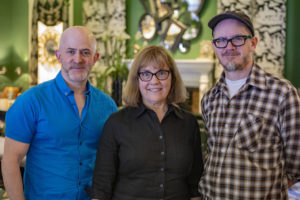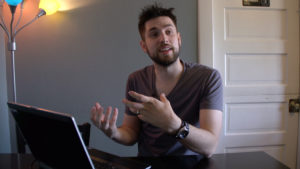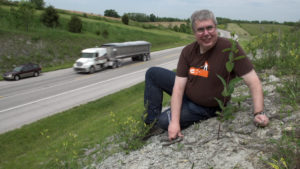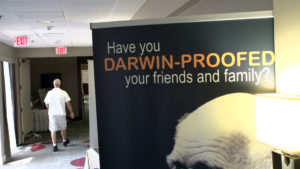AFI DOCS 2019: Interview with Directors Clayton Brown and Monica Long Ross of “We Believe in Dinosaurs”
Written by: Christopher Llewellyn Reed | June 24th, 2019

On Friday, June 21, at the 2019 AFI DOCS, I interviewed directors Clayton Brown and Monica Long Ross (The Believers) to discuss their collaboration on the new documentary We Believe in Dinosaurs. The film chronicles the construction of the Ark Encounter, a “life-size” model of Noah’s Ark funded and built by Answers in Genesis, a creationist organization that promotes the belief that the Earth is no more than 6000 years old (give or take). The members of the group actually do believe in dinosaurs (hence the movie’s title), but think that they co-existed with humans. Featuring interviews with scientists, religious fundamentalists, and even one former creationist, David MacMillan, who has come over to the side of evolution, We Believe in Dinosaurs is both fascinating and, if you believe in science and evolution, deeply troubling. Here is a condensed digest of our conversation, edited for length and clarity.
Christopher Llewellyn Reed:How did you choose this particular subject?
Monica Long Ross: We at 137 Films do science and culture. We’re both fascinated by science and find it a deep well of stories. When we were working on our first film together, The Atom Smashers, which is about the search for the Higgs boson, the Dover court case was going on about intelligent design and putting creationism into the classroom. Ever since then we’ve been following this and one of our discussions, between the two of us, is how do we tackle … because we’re always doing science and culture clashing … how do we tackle religion and science? What story could we come up with? And when we heard that they were building a life-size Noah’s ark with an intention of teaching about their kind of science and their version of science, we thought that it was an important story to tell and that it was just up our alley. So we started following it.
CLR: Where does that initial interest in science and culture come? Did you study science at one point or just always have an interest in it?
Clayton Brown: No. We were always just sort of interested in it. After we finished film school, a group of us wanted to get together and form a documentary company. And so, we realized that there wasn’t a lot of coverage happening in this intersection of science and culture, which is where we wanted to go. Most of the time when you see science documentaries, they’re the type where scientists explain things to you and teach you about things and point to things. But we were storytellers. Monica’s a playwright and I do some writing, also. We wanted to have the scientists be characters in these stories, because a lot of times, what happens behind the scenes that you don’t see is really fascinating.
And so, pretty quickly, we realized, as everyone knows, there’s a lot of tension in America between science and culture. There’s where science and greed meet, where science and morality, science and religion, science and politics and science and education meet. Everywhere, there’s friction and tension buzzing around. So that’s where we ended up locating.

CLR: Right. And particularly, in today’s America, where we seem to see these dichotomies going ever further apart. How did you negotiate access with your various subjects? The creationists, led by Ken Ham, seem very eager to tell their story, even if it’s possible that they might suspect you of your own agenda.
CB: Well, the interesting thing about them is how media-savvy and media-ready they are and how they crave and seek out media coverage and media attention. They take everybody on. They welcome everybody, because they’re so confident in what they believe, they feel like, “There’s a good chance we could minister to you,” or, “We’re not threatened by your beliefs.”So, we first asked them about making a documentary about the Ark Encounter, and they said, “No. There’s already a documentary film crew making one.” So we thought, “OK, maybe we can come in the back door.” So, we went to a creation-science conference, of which there’s a couple of scenes in the film in Pittsburgh in 2013. That was the first thing we did. And there, we met some people, like Georgia Purdom from Answers in Genesis and the Creation Museum.
CLR: She’s the PhD.
CB: Yeah. One of their three.
CLR: One of their three who gives them some sort of legitimacy, supposedly, in the scientific community.
MLR: True.
CB: So, we started talking with her and she agreed to let us come to an interview at the Creation Museum. So, we did and while we were there, we just said, “Well, could we talk to your design team? We’re interested in seeing these preparations for the Ark Encounter.” And so, she introduced us to their head designers and we were off to the races, really.
MLR: And they allowed us in. It sometimes surprised us that they would always say yes, but they did. And I think they are very proud of what they’re doing and they’re confident that they have the answers. And so, they’re not shy about telling you that they have the answers.
CLR: Ken Ham reminds me of many blustering showmen from American history, like a P.T. Barnum of the creationist world, and he is not lacking in confidence. And he was in the Bill Nye: Science Guydocumentary debating a legitimate scientist. So, I’m curious, then, was there anything that you were not allowed to film? Because you have such seemingly unlimited access.
MLR: There were individuals outside of Answers in Genesis and the museum that said that they were not comfortable being on camera. And there were people in David MacMillan’s family who were not comfortable being on camera. And we absolutely respected that. We asked them and they said no. And when we went to the creation conference in Pittsburgh, there were individuals saying, “I really want to talk to you, but I don’t want to do it on camera.” And so, some of the more really interesting debates happened between Clayton and a gentleman who does tours to the Grand Canyon and to Mount Saint Helen and other places that they have carved out as evidence of the flood.

And it was hard, because they said no. And so, I wanted to put the camera on that because there was some really interesting things being said, but it was our first trip and we went with a great deal of curiosity and so we got a lot of insight from those kinds of interviews, but documentary filmmakers hate it when somebody won’t do it on camera. So, we had to just pull back.
CB: Institutionally, they basically never said no, except for the debate, the specific debate. We could watch the debate. We couldn’t film the debate. That’s the Bill Nye vs. Ken Ham debate. But that was the only thing that they said we couldn’t do.
CLR: Interesting. Have any of them seen the finished film?
CB: Not yet.
MLR: Unless they came to a festival.
Clayton Brown: Doug Henderson, the sculptor, asked if he could and I said yes. We’ve been in contact. But if you watched the film all the way through the credits, the end of the credits, where they reacted to us and the film even though they had not seen it. They claimed we misrepresented ourselves and that we were out to destroy … They hadn’t seen the film, so they don’t really know. But actually, we feel fairly confident that there’s not a lot there that they can object to in a lot of ways. Because we’re just recording them talking.
CLR: Although, through the power of editing, of course, even if you’re simply showing their words, by the juxtapositions of them to your scientists – the legitimate scientists, that is like that guy from Kentucky, Dan Phelps – that juxtaposition could perhaps make their words seems less legitimate, because in the editing, you’re carefully going back and forth. So perhaps they would object to that, but I would agree that at least it seems to me like what they believe is being fairly represented.
CB: Right.
MLR: And we made certain decisions, and one decision was that we were only going to have voices from Kentucky. There’s a few who are not: Rob Boston, from DC, and another creationist who comes out of Florida and he’s at the opening.
CB: Eric Hovind.

MLR: But the main characters are all from Kentucky, so it wasn’t someone coming from the outside. We didn’t put a lot of scientists in there to say how bad their science was. We put a local activist in there, Dan Phelps, who speaks about that. So, it’s voices from Kentucky. It’s treated as their struggle, because they want to protest it and they don’t want it there. And that was really important to us.So, they can’t really hold it up as someone coming from Chicago telling them what to believe. This is a local issue from the tax standpoint, from all of it, it was a local issue. And the other side is, we wanted them to recognize themselves. So, as Clayton says, we just had them talk and we recorded them. So, though we have a juxtaposition with other characters from Kentucky saying they’re wrong, we didn’t edit them in such a way to mock them. And that was important to us.
CLR: So, where did the startling statistic come that 38% of Americans apparently believe that the Earth is less than 10,000 years old.
CB: It says they believe that humans were created in their present form by God less than 10,000 years ago.
CLR: Right. That’s a huge number, about in line with the support of our current president, in terms of the percentage. But where does that come from? How was that statistic gathered?
CB: It’s Gallup, a Gallup poll that they ask every year.
CLR: Are there any more specificities within that in terms of regions of the United States where that belief is more strongly held than in others?
MLR: I don’t think so. Not that we’re aware of.
CLR: Gallup just asks generally?
CB: I’m not sure what their polling methods are, but they’ve got that stuff figured out.
CLR: OK. Well, it is alarming.
CB: Yeah.
CLR: So, how long have you two known each other and been working together?

MLR: We were in an MFA program at Northwestern together, so and that was in … when did we graduate?
CB: We started in ’99 and finished in ’03, ’04, something like that.
CLR: How do you divide the labor as co-directors? Does one person do more of one thing or is it just whoever’s available? How does that happen?
MLR: Well, Clayton shoots and Clayton edits. I write and I’m usually the face asking the questions. And a lot of times, it’s just Clayton and I, running around with equipment, doing … especially when we do interviews, we want it very intimate. We don’t want to bring a crew in. Then it’s just Clayton and I, setting up.
CLR: Sure. Right. And you’re holding the microphone while Clayton’s shooting?
MLR: I’m holding the microphone and he’s behind the camera and I’m asking questions.
CB: Yeah. Or if it’s a sit-down interview, we’ve got a lav mic and a boom. But sometimes, also, our producer Amy [Ellison] will come along with us and do sound work.
MLR: Absolutely.
CB: But rarely more than three of us. I think that gives the film a certain intimacy, maybe. I think because we just go and show up without a big production footprint, so the production values, I think, are fine. I wouldn’t say that it’s gorgeous with cranes and dollies and all that. But that’s just the way we work. We’re more vérité.
CLR: Well, congratulations on the film. It’s a really disturbing but fascinating look at a part of the United States that I really don’t pay attention to. So, thank you!
Both: Thanks!



